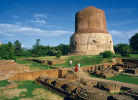Holy Places in Varanasi
1. Bharat Mata Temple
Inaugurated by the Father of Nation Mahatma Gandhi, it cherishes the relief map of country in pure white marble. The map depicts un-divided India as it was constructed before division of India and Pakistan. One can see clearly marked out oceans, plains and mountains which are in perfect condition till date.
The temple stands on five pillars each representing earth, fire, wind, water and sky- the five basic elements of survival. All the pillars merge to make a common roof representing that all the five elements finally merge into one – the supreme God – the protector of all.
It’s located inside Banaras Hindu University and is open from 09:30 a.m. – 08:00 p.m.
2. Tulsi Manas Temple
In the first look it does not give a very good impression but inside it’s a different view. But inside it’s definitely worth a visit. Built in 1964, it is the only place in entire India where Ramayana is written in HINDI on the walls of entire temple.
The walls of Tulsi Manas temple is engraved with verses and scenes from this Hindu epic. On the first floor is a beautiful Kathputli idol” which are operated on special occasions and festival. In general days, it’s open for people to see for a very small fee. The temple is open from 05:30 a.m. – 12:00 noon and 03:30 a.m. -09:00 p.m.
3. Durga Temple
From a distance itself you can recognize the temple itself by the striking red colour which looks like a flame. Interestingly this beautiful temple of Maa Durga is much revered in a place where Lord Shiva has much more importance as well as followers. Constructed by a Bengali Maharani in the 18th century; it is said that Maa Durga appeared here herself and so the temple got its importance.
This place is one of the best place representing North Indian style of architecture positioned over a rectangular tank called Durga Kund with multi – tiered Shikara with spires which keep on decreasing with increasing height. It is on the occasion of NAVRATRI that the temple sees hundreds of people coming here…..
4. Tomb of Lal Khan
This land of hindus has interestingly got many mausoleums built during the Musilm reign era. Constructed in the year 1773, this tomb made in the remembrance of Lal Khan – a noble mughal; it truly depicts Muslim architecture. Its pillars and walls are truly impressive and worth a visit. Open from 09:00 a.m. – 05: 00 p.m.; it can be visited at any time.
5. Gyaan Kupoor Well
As the legend goes, Gyaan Kupoor Well has been in Varansi even before river Ganges flowed down to earth. Believed to be a form of enlightenment, it’s a much visited by pilgrims of Benaras. Before visiting any other place, pilgrims come here to take “sankalpa” and then move on to other places.
This place has other importance too. Non – hindus are not allowed inside Vishwanath Temple. It is from a hole in a particular wall if the temple from where they can see the temple. This hole is very near to Gyaan Kupoor Well.











